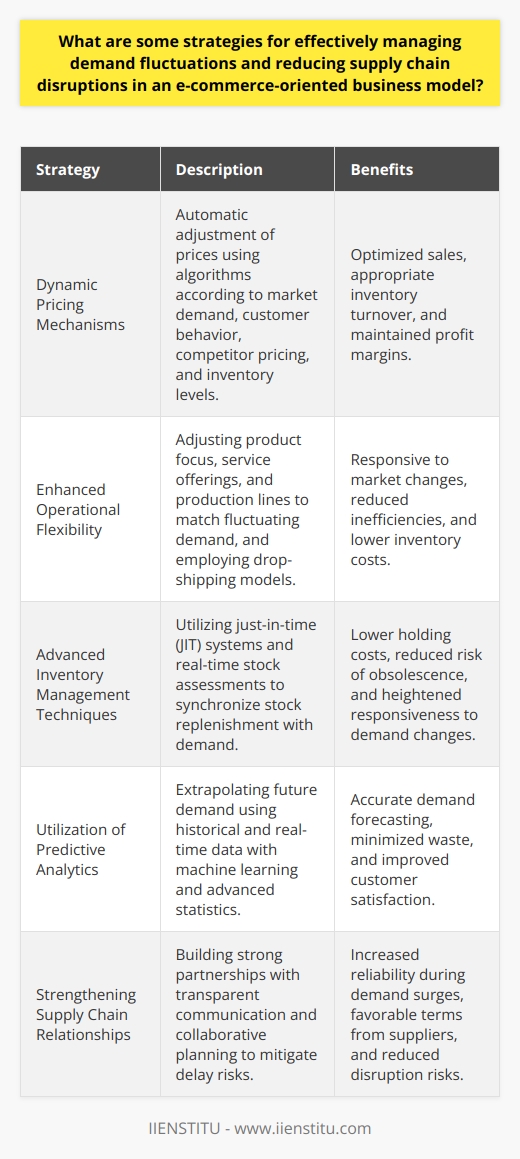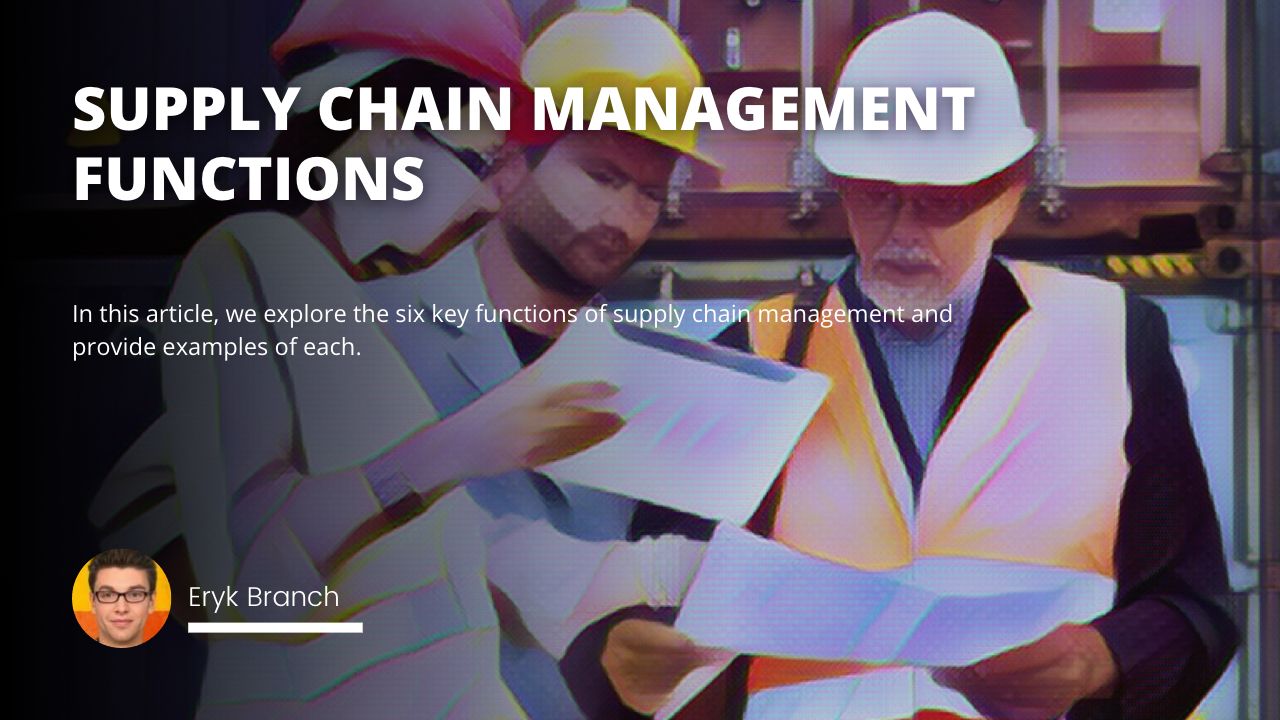
Stepping into a bustling warehouse, the hum of forklifts echoing around me, boxes stacked high to the ceiling, and a flurry of activity as workers move goods in and out, I recall my first job fresh out of college, working for a mid-sized logistics company. The chaos that often ensued when a shipment was delayed or when inventory didn't match our records was a vivid memory. It was in those moments that I realized the immense value of efficient supply chain management and how e-business solutions for supply chain management could revolutionize the way we operated.
Introduction
Benefits of E-Business Solutions for Supply Chain
Tailor-Made vs. Standard Packages
Challenges of Implementing E-Business Solutions
Conclusion
In today's fast-paced business environment, integrating e-business solutions into supply chain management isn't just a trend—it's a necessity. Companies are constantly seeking ways to optimize supply chain management processes to stay competitive. But what exactly does this mean? E-business solutions refer to the use of internet-based technologies to conduct business processes. In the realm of supply chain management, this involves using software and digital tools to manage logistics, inventory, procurement, and distribution activities. By leveraging these tools, businesses can achieve greater efficiency, reduce costs, and improve customer satisfaction.
Benefits of E-Business Solutions for Supply Chain
First, they can improve customer service by providing customers with faster, more accurate information about their orders. This can help businesses build customer loyalty and increase sales.
Second, e-business solutions can help businesses reduce costs by streamlining the supply chain and eliminating redundant processes.
Third, e-business solutions can improve profitability by helping businesses make better decisions about pricing, inventory management, and other aspects of the supply chain. Finally, e-business solutions can help businesses stay competitive by providing them with the latest information about the market and their competitors.
The benefits of e-business in logistics are numerous. First, they can improve customer service by providing customers with faster, more accurate information about their orders. This can help businesses build customer loyalty and increase sales. Second, e-business solutions can help businesses reduce costs by streamlining the supply chain and eliminating redundant processes. Third, e-business solutions can improve profitability by helping businesses make better decisions about pricing, inventory management, and other aspects of the supply chain. Finally, e-business solutions can help businesses stay competitive by providing them with the latest information about the market and their competitors.
Logistics Mgmt: Optimizing Customer Service During Order Postponement
Optimizing Order Process Time: A Key to Successful Supply Chain Management
First, implementing an e-business solution can be costly and time-consuming.
Second, the software must be tailored to the business's specific needs, which can be difficult and expensive.
Third, the software must be maintained and updated regularly, which can also be costly. Finally, the software must be integrated with the business’s existing systems, which can be difficult and time-consuming.
I remember a time when our company integrated an SCM (supply chain management) system. The transformation was remarkable. Not only did we see a significant reduction in delivery times, but we also noticed that customer complaints dropped by nearly 30%. This experience highlighted the tangible benefits of embracing e-business solutions in supply chain management.
Tailor-Made vs. Standard E-Business Solutions
When considering e-business solutions, companies often face the dilemma of choosing between tailor-made vs standard e-business solutions. Tailor-made packages are customized to meet the specific needs of a business. They offer personalization, scalability, and a competitive edge. However, they come with challenges such as higher costs, longer implementation time, and dependence on developers.
E-Business Solutions can be the key to unlocking the potential of Logistics Management.
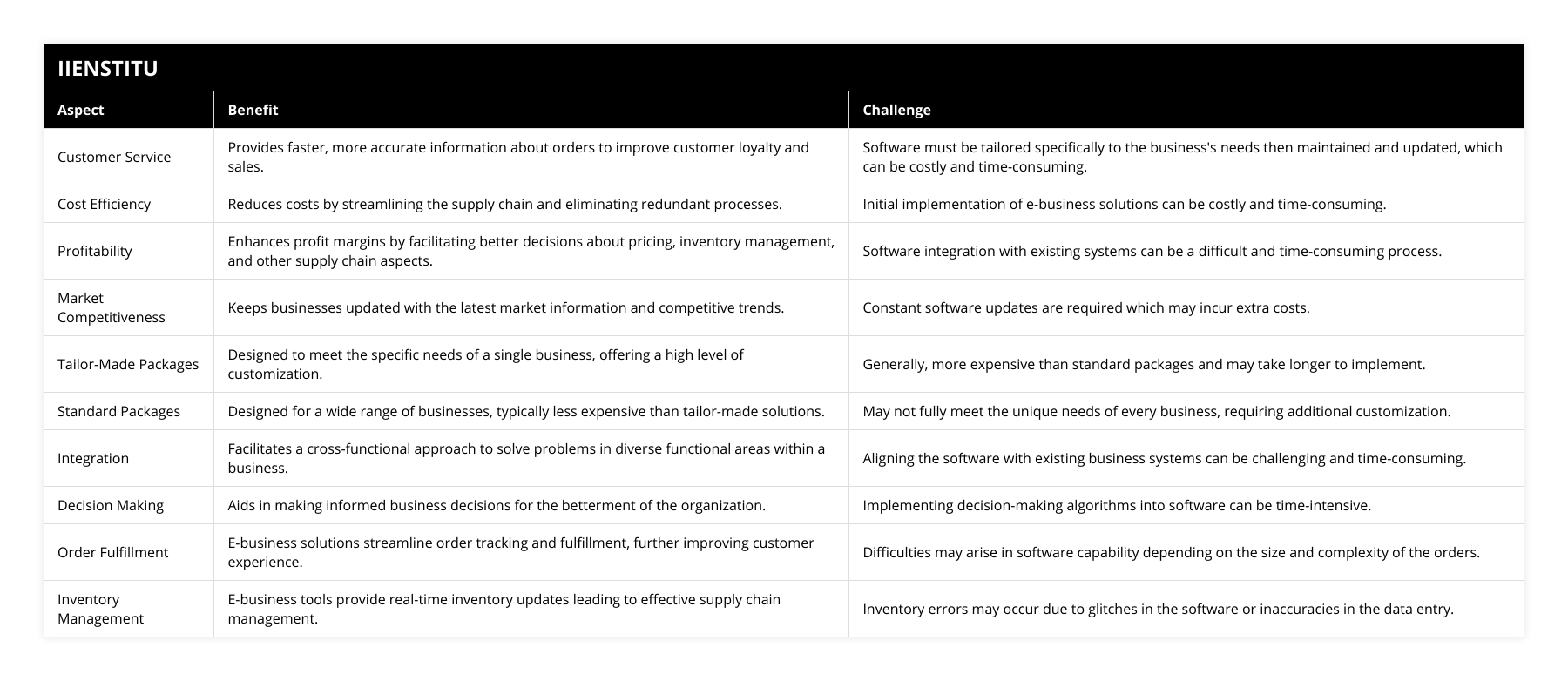
On the other hand, standard packages are off-the-shelf solutions designed to cater to a wide range of businesses. They are generally more cost-effective, have faster deployment, and proven reliability. However, they might not fit perfectly, have limited customization options, and may not provide a competitive differentiation.
From my experience, smaller companies or those new to e-business might opt for standard packages to test the waters. In contrast, larger organizations with specific needs might invest in tailor-made solutions to gain a competitive advantage in supply chain management.
Challenges of Implementing E-Business in Supply Chain
While the benefits are substantial, implementing e-business solutions isn't without its hurdles. The high initial investment can be a significant barrier, not just in terms of monetary investment but also the time and resources required. Businesses need to consider software and licensing fees, hardware upgrades, training for staff, and ongoing maintenance costs.
Integration with existing systems can also pose compatibility issues. Legacy systems may require overhauling existing infrastructure or developing middleware to allow systems to communicate. Employee resistance is another challenge, as change can be daunting. Employees accustomed to certain workflows may resist new systems, fearing job redundancy or simply struggling with new technology.
Maintenance and upgrades are ongoing concerns. Technology evolves rapidly, and keeping e-business solutions up-to-date requires ongoing investment. There's also the risk of technological obsolescence, where systems become outdated quickly. Data security is another critical concern, as increased digitalization comes with the heightened risk of cyber threats.
To mitigate these challenges of implementing e-business in supply chain, companies should:
1- Conduct thorough planning to understand the needs and align them with the solution's capabilities.
2- Engage stakeholders early to involve employees in the decision-making process and gain buy-in.
3- Invest in training to ensure that users are comfortable and proficient with the new systems.
4- Plan for the future by choosing scalable solutions that can evolve with the business.
Cost Reduction in Supply Chain Management
One of the primary drivers for adopting e-business solutions in supply chain management is cost reduction. By automating processes, improving coordination, and enhancing visibility, businesses can significantly reduce operational costs. For instance:
Inventory management systems can minimize holding costs by accurately predicting demand.
Automated order processing can reduce manual errors and save time.
Real-time tracking can optimize routes and reduce transportation costs.
Collaborative platforms can streamline communication and reduce administrative overhead.
I recall an incident where our company faced a sudden spike in demand for a particular product. Thanks to our e-business solution's real-time inventory visibility, we were able to quickly identify the shortage and coordinate with suppliers to ramp up production. This proactive approach not only prevented stockouts but also saved us from potential lost sales and customer dissatisfaction.
Electronic Supply Chain Management Advantages
The advantages of electronic supply chain management extend beyond cost reduction. Improved customer service is a key benefit. Customers today expect fast, reliable service, and e-business tools provide them with up-to-date information on their orders, shipping status, and availability of products. This transparency builds trust and fosters customer loyalty.
E-business solutions also enable better decision-making. With access to real-time data and analytics, businesses can make informed decisions about pricing strategies, resource allocation, and process optimization. This leads to increased profitability and enhanced competitiveness.
Moreover, electronic supply chain management improves collaboration among stakeholders. Suppliers, manufacturers, distributors, and retailers can seamlessly share information, coordinate activities, and respond quickly to changes in demand or supply. This level of collaboration is crucial in today's interconnected business landscape.
Improving Customer Service through E-Business
Improving customer service through e-business is a top priority for many organizations. E-business solutions provide a range of tools to enhance the customer experience:
Order tracking: Customers can easily track their orders in real-time, reducing anxiety and improving satisfaction.
Self-service portals: Customers can access information, place orders, and manage their accounts independently.
Personalized recommendations: Based on customer data and purchase history, e-business solutions can offer personalized product recommendations, increasing cross-selling and upselling opportunities.
Faster response times: Automated systems can quickly process orders, respond to inquiries, and resolve issues, reducing customer wait times.
I remember a case where a customer urgently needed a spare part for their equipment. Our e-business solution's real-time inventory visibility allowed us to quickly locate the part in a nearby warehouse and arrange for same-day delivery. The customer was thrilled with the prompt service, and this experience strengthened our business relationship.
Integrating E-Business Solutions in Logistics
Integrating e-business solutions in logistics is a complex undertaking that requires careful planning and execution. Key considerations include:
1- Assessing current processes and identifying areas for improvement.
2- Defining clear objectives and success metrics for the e-business implementation.
3- Selecting the right technology partners and solutions that align with the business needs.
4- Developing a comprehensive project plan with milestones, timelines, and responsibilities.
5- Engaging stakeholders across the organization to ensure buy-in and smooth adoption.
6- Providing adequate training and support to users during and after the implementation.
7- Continuously monitoring and optimizing the e-business solutions to drive ongoing improvements.
In my experience, successful integration of e-business solutions in logistics requires a collaborative effort between IT, operations, and business teams. It's essential to have a clear vision, strong leadership, and effective change management to navigate the complexities and realize the full potential of e-business in logistics.
Future of Supply Chain Technology
The future of supply chain technology is exciting and transformative. Emerging technologies such as artificial intelligence (AI), the Internet of Things (IoT), and blockchain are set to revolutionize supply chain management even further.
AI and machine learning can enhance forecasting accuracy, optimize routes, and automate decision-making processes. IoT devices enable real-time tracking of goods, equipment, and vehicles, improving visibility and control over the entire supply chain. Blockchain technology offers secure, transparent, and tamper-proof record-keeping, which can be particularly beneficial in tracking the provenance of goods and ensuring compliance with regulations.
As these technologies mature and become more widely adopted, we can expect to see more agile, responsive, and intelligent supply chains. Businesses that stay ahead of the curve and embrace these innovations will be well-positioned to thrive in the future.
Real-World Examples of Supply Chain E-Business Solutions
To illustrate the impact of e-business solutions in supply chain management, let's look at some real-world examples:
1- Amazon's Fulfillment by Amazon (FBA): Amazon's FBA program is a prime example of how e-business solutions can transform logistics. Sellers can store their products in Amazon's warehouses, and Amazon handles the picking, packing, shipping, and customer service. This allows sellers to focus on their core business while leveraging Amazon's extensive logistics network and e-business capabilities.
2- Walmart's Supplier Portal: Walmart's supplier portal is a collaborative e-business platform that connects Walmart with its suppliers. It enables real-time information sharing, order management, and performance tracking. This portal has significantly improved Walmart's supply chain efficiency, reduced costs, and strengthened supplier relationships.
3- UPS's Internet of Things (IoT) initiative: UPS has implemented IoT devices in its vehicles and warehouses to track assets, monitor conditions, and optimize routes. This real-time data has enabled UPS to improve delivery times, reduce fuel consumption, and enhance customer service.
These examples demonstrate how e-business solutions can be applied in different aspects of supply chain management, from fulfillment and supplier collaboration to asset tracking and route optimization. By embracing these solutions, businesses can achieve significant improvements in efficiency, cost savings, and customer satisfaction.
Conclusion
In conclusion, embracing e-business solutions in supply chain management is no longer a choice but a necessity in today's fast-paced, highly competitive business environment. The benefits of e-business in logistics, such as cost reduction, improved customer service, and increased profitability, make a compelling case for adoption.
However, implementing e-business solutions comes with its own set of challenges. Companies must carefully consider their specific needs and choose between tailor-made and standard solutions. They must also be prepared to invest in the necessary resources, training, and change management to ensure successful implementation.
Looking ahead, the future of supply chain technology is exciting, with emerging technologies like AI, IoT, and blockchain promising to further revolutionize the field. Businesses that stay agile, innovative, and open to these advancements will be well-positioned to thrive in the digital age.
As I reflect on my own journey, from the chaotic warehouse of my first job to the highly optimized supply chains of today, I am amazed by the transformative power of e-business solutions. It's clear that the successful integration of these solutions is not just about adopting new technologies but also about fostering a culture of continuous improvement and collaboration.
So, to all the businesses out there, I ask: Is your supply chain ready for the future? Embracing e-business solutions may be the key to unlocking your full potential and staying ahead in the ever-evolving landscape of logistics and supply chain management.
References
1- Chopra, S., & Meindl, P. (2016). Supply Chain Management: Strategy, Planning, and Operation. Pearson.
2- Simchi-Levi, D., Kaminsky, P., & Simchi-Levi, E. (2008). Designing and Managing the Supply Chain: Concepts, Strategies, and Case Studies. McGraw-Hill.
3- Christopher, M. (2016). Logistics & Supply Chain Management. Pearson UK.
4- Ross, D. F. (2016). Introduction to Supply Chain Management Technologies. CRC Press.
5- Daugherty, P. R., & Wilson, H. J. (2018). Human + Machine: Reimagining Work in the Age of AI. Harvard Business Review Press.
Frequently Asked Questions
What are the main benefits of using e-business solutions for supply chain management?
The use of e-business solutions for supply chain management (SCM) offers businesses a wide range of benefits. This article will discuss the main advantages of e-business solutions in SCM.
One main benefit of e-business solutions for supply chain management is improved efficiency. By streamlining processes and leveraging technology, e-business solutions offer businesses the ability to automate manual processes, reduce paperwork, and reduce labor costs. Additionally, e-business solutions enable businesses to track and manage inventory in real time, allowing them to identify and address changes in inventory levels quickly.
Another benefit of e-business solutions for SCM is increased visibility. By providing a comprehensive view of the supply chain, e-business solutions allow businesses to understand better and manage their supply chain activities. E-business solutions also enable businesses to monitor the performance of their suppliers and other stakeholders, allowing them to identify any potential risks or inefficiencies in their supply chain.
E-business solutions for supply chain management also enable businesses to improve customer service. By automating processes and leveraging technology, businesses can reduce lead times and improve order accuracy, leading to better customer satisfaction. Additionally, e-business solutions enable businesses to provide customers with up-to-date information on orders and shipments, allowing them to manage their own expectations better.
Finally, e-business solutions for supply chain management allow businesses to reduce costs. By streamlining processes and leveraging technology, businesses can reduce operational costs, such as labour and inventory costs, as well as the costs associated with managing and maintaining the supply chain. Additionally, e-business solutions enable businesses to reduce the costs associated with managing and fulfilling orders, leading to further cost savings.
In conclusion, e-business solutions for supply chain management offer businesses a wide range of benefits. By streamlining processes and leveraging technology, e-business solutions enable businesses to improve efficiency, increase visibility, improve customer service, and reduce costs. As such, e-business solutions are a valuable tool for businesses looking to optimize their supply chain activities.
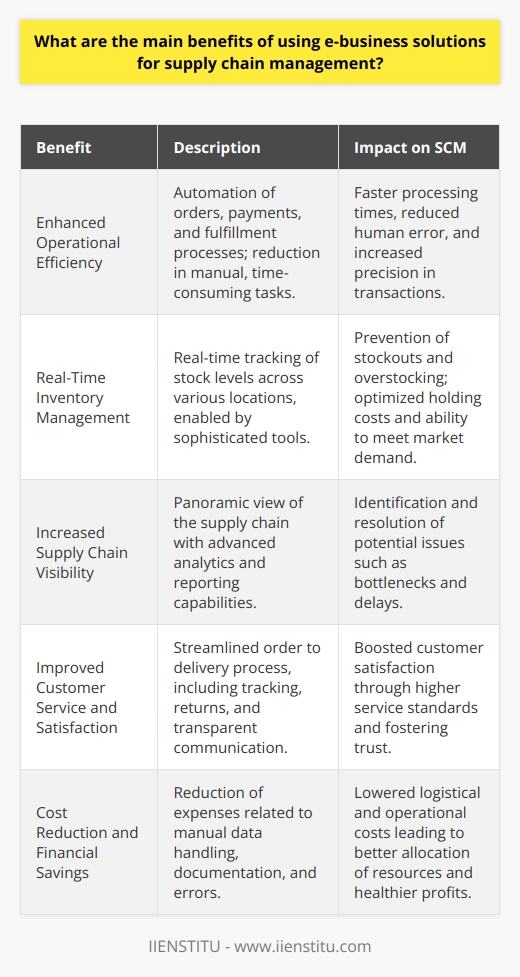
How can companies tailor e-business solutions to their specific needs?
E-business solutions are becoming increasingly popular as businesses strive to optimize their operations. This trend has presented companies with the challenge of tailoring such solutions to their specific needs in order to maximize the benefits. Companies have to consider a variety of factors when determining how to tailor e-business solutions to their needs.
The first step is to identify the exact needs of the company. Companies need to assess their current operations to determine what areas could be improved with the use of e-business solutions. This assessment should include an evaluation of customer requirements, business processes, data and information management, and other operational areas. Once the needs of the company are identified, then the company can begin to tailor the e-business solution accordingly.
The second step is to determine the type of e-business solution that best meets the company’s needs. Companies must consider a variety of factors such as cost, scalability, and integration when selecting an e-business solution. Companies should also consider the security measures, support services, and customization options of the e-business solution. This is important in order to ensure that the e-business solution is able to meet the company’s specific needs.
The third step is to develop the e-business solution. Companies must ensure that the e-business solution is properly configured and optimized to meet the company’s specific needs. This includes developing the necessary software applications, integrating the e-business solution with existing systems, and testing the solution to ensure that it is running smoothly.
Finally, companies must ensure that they are able to effectively manage the e-business solution. Companies must have a good understanding of the e-business solution and how it works to maintain and update it properly. Companies should also ensure that they have the necessary personnel to manage the e-business solution and provide adequate user support.
In conclusion, companies must take a systematic approach when tailoring e-business solutions to their specific needs. Companies must identify their needs, select an appropriate e-business solution, develop it, and manage it effectively. By doing so, companies can ensure that their e-business solutions are able to meet their specific needs and help optimize their operations.

What challenges should companies be aware of when implementing e-business solutions for logistics management?
E-business solutions are becoming increasingly popular in the logistics industry, offering a range of benefits to companies, including cost savings, improved customer service, and better supply chain visibility. However, companies must be aware of the challenges that accompany the implementation of e-business solutions for logistics management.
The first challenge is establishing the infrastructure necessary to implement and maintain the e-business solution. Depending on the size of the company, this may require a significant investment in hardware and software. Companies should also consider the cost of ongoing maintenance and training. Without a clear understanding of the costs associated with the implementation, companies may find themselves in a difficult financial situation.
Another challenge is data security. As the logistics industry deals with large amounts of sensitive customer data, companies must ensure that the e-business solution is secure. This requires a comprehensive security protocol that is regularly monitored and updated. Companies should also consider the implications of data breaches and how they would respond in such a situation.
Finally, companies should consider the cultural implications of implementing an e-business solution. Many companies rely on relationships with suppliers, customers and other industry stakeholders to operate efficiently. As e-business solutions can sometimes be seen as a threat to these relationships, companies must ensure that they communicate the benefits of the e-business solution to all affected parties.
In conclusion, e-business solutions can provide significant benefits to the logistics industry. However, companies must be aware of the challenges associated with implementing an e-business solution for logistics management. These include establishing the necessary infrastructure, ensuring data security, and managing the cultural implications of the change. Companies can ensure that their e-business solution is successful by taking the time to understand these challenges.
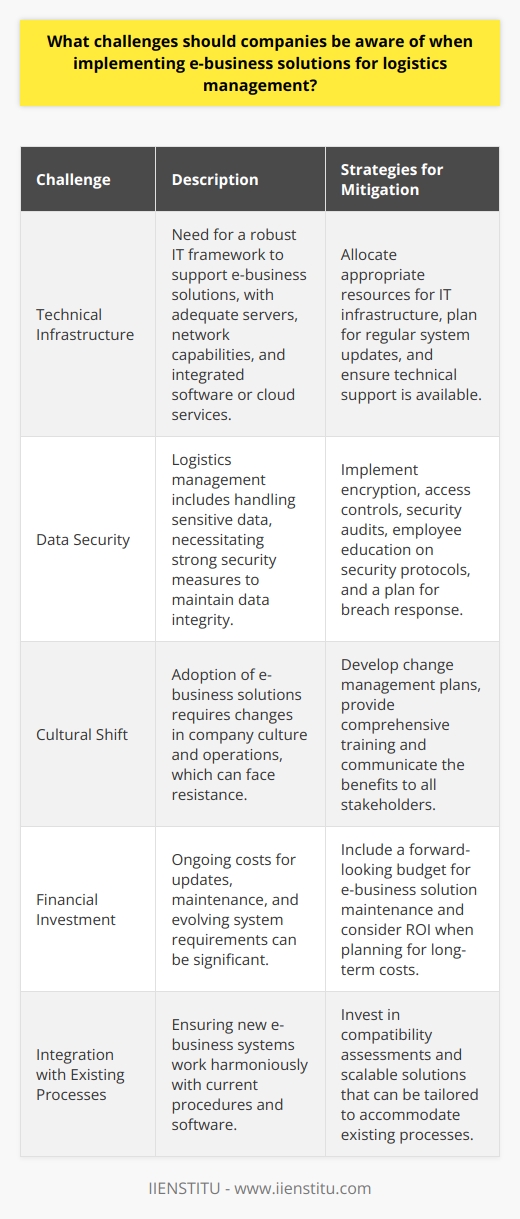
What are the key components of an effective logistics solution for ecommerce?
**Essential Components of E-Commerce Logistics Solutions**
Effective e-commerce logistics solutions involve an integration of several key components that ultimately contribute to higher efficiency, cost reduction, and enhanced customer experience. To begin with, an advanced inventory management system is crucial for the timely and accurate tracking of products, ensuring that orders are picked, packed, and dispatched efficiently.
**Warehouse Management and Automation**
An effective logistics solution also employs a robust warehouse management system (WMS) that allows for efficient organization and prioritization of tasks, such as product storage, order picking, and shipping. Automation plays a significant role in enhancing warehouse operations, utilizing technologies like robotics and artificial intelligence to speed up processes and reduce human intervention.
**Transportation and Carrier Management**
The integration of a well-designed transportation management system (TMS) is essential for finding the most cost-effective and efficient routes, carriers, and shipping modes. A TMS helps businesses optimize their transportation networks by consolidating shipments, automating routing decisions, and negotiating better shipping rates with carriers. It also facilitates accurate tracking and monitoring of shipments in real-time, enabling swift reaction to any unforeseen disruptions.
**Technology Integration and Data Analytics**
The ability to gather, analyze, and utilize data effectively is a vital aspect of any e-commerce logistics solution. Integrating various technologies, such as barcoding, RFID, IoT sensors, and GPS tracking, can significantly improve visibility and provide insights into supply chain performance. Data analytics tools empower businesses to make well-informed decisions and implement continuous improvement initiatives in their logistics operations.
**Customer-Oriented Approach**
Lastly, an indispensable component of a successful logistics solution is its focus on providing an exceptional customer experience. This involves offering flexible and convenient delivery options, such as same-day or next-day delivery, easy returns, and real-time updates on shipment status. A customer-centric approach ensures that businesses can retain and attract more customers, maintain a competitive edge, and ultimately drive growth.
In conclusion, an effective logistics solution for e-commerce hinges on a seamless integration of various components, such as inventory management, warehouse automation, transportation optimization, data analytics, and a customer-oriented approach. By incorporating these elements, businesses can streamline their supply chain operations, reduce costs, and provide an exceptional end-to-end customer experience.

How can data analytics and machine learning contribute to the optimization of a supply chain for ecommerce?
Enhancing Demand Forecasting
Data analytics and machine learning contribute significantly to the optimization of supply chains in the e-commerce landscape by improving demand forecasting. Precise demand predictions are crucial in supply chain management, as they help businesses cater effectively to customers' needs while minimizing costs. Machine learning algorithms analyze historical data and identify patterns, enabling companies to forecast demand more accurately than traditional methods.
Inventory Management and Replenishment
Another key area where data analytics and machine learning provide significant improvements is in inventory management and product replenishment. By leveraging these technologies, e-commerce platforms can optimize inventory levels and reduce stockouts. E-commerce businesses can automate the order placement and replenishment process, ensuring that products are available as needed without accumulating excessive inventory costs.
Personalization and Customer Satisfaction
E-commerce platforms need to understand their customers' behavior and preferences to deliver personalized shopping experiences. Data analytics and machine learning techniques help businesses create customer profiles, enabling them to offer personalized product recommendations and promotions. As a result, customer satisfaction and conversion rates improve, directly impacting supply chain efficiency.
Dynamic Pricing
Data analytics and machine learning can also assist e-commerce platforms in implementing dynamic pricing strategies, further optimizing supply chain performance. Dynamic pricing combines demand and supply factors with other variables such as competitor prices, seasonal fluctuations, and promotional activities. Machine learning algorithms can analyze this information and generate appropriate pricing decisions, ensuring that e-commerce platforms optimize revenue while effectively managing inventory levels.
Supply Chain Risk Management
Data analytics and machine learning enhance supply chain risk management by detecting and mitigating potential disruptions. Using advanced algorithms, e-commerce platforms can analyze vast amounts of data from various sources to identify vulnerabilities and assess risk levels. With this information, they can develop effective mitigation strategies, ensuring that supply chain operations continue smoothly even in the face of potential disruptions.
In conclusion, by leveraging data analytics and machine learning, e-commerce businesses can optimize their supply chains by enhancing demand forecasting, inventory management, personalization, dynamic pricing, and risk management. These technologies enable e-commerce organizations to deliver better customer experiences, improve operational efficiency, and foster business growth.

What are the main factors influencing the relationship between ecommerce and logistics, and how can they be managed to improve operational efficiency?
Key Factors in Ecommerce-Logistics Relationship
The most prominent factors influencing the relationship between ecommerce and logistics include supply chain management, customer expectations, technology, and global reach. Understanding and managing these factors effectively can potentially lead to improved operational efficiency for both ecommerce retailers and logistics service providers.
Efficient Supply Chain Management
An efficient supply chain is critical in ensuring a seamless flow of goods from the manufacturer to the end consumer. Ecommerce platforms must collaborate with their logistics partners to integrate systems, streamline order fulfilment processes, and reduce lead times. This will not only enhance customer satisfaction but also reduce operational costs.
Meeting Customer Expectations
Meeting customer expectations is vital in maintaining a successful ecommerce-logistics relationship. Online businesses must work closely with logistics providers to offer flexible delivery options, such as same-day or next-day delivery and easy return policies. This will lead to increased customer satisfaction, repeat purchases, and positive word-of-mouth marketing.
Incorporation of Advanced Technologies
The use of advanced technologies, such as artificial intelligence, machine learning, and data analytics, can help both ecommerce companies and logistic service providers to optimize inventory management, route planning, demand forecasting, and order tracking. These technologies create a more cohesive and efficient relationship between ecommerce and logistics, ultimately enhancing overall operational efficiency and customer experience.
Expanding Global Reach
As ecommerce platforms expand their global reach, the need for a robust and flexible logistics network becomes more imperative. To address this challenge, ecommerce companies should partner with logistic service providers with extensive geographical coverage and expertise in handling international shipping requirements. This will enable the companies to tap into new markets, while ensuring that goods are delivered efficiently and on time.
Conclusion
In conclusion, effective management of supply chain efficiency, customer expectations, advanced technologies, and global reach can significantly impact the relationship between ecommerce and logistics. By addressing these factors, both ecommerce retailers and logistics service providers can improve operational efficiency, ensure seamless order fulfilment, and ultimately enhance customer satisfaction.
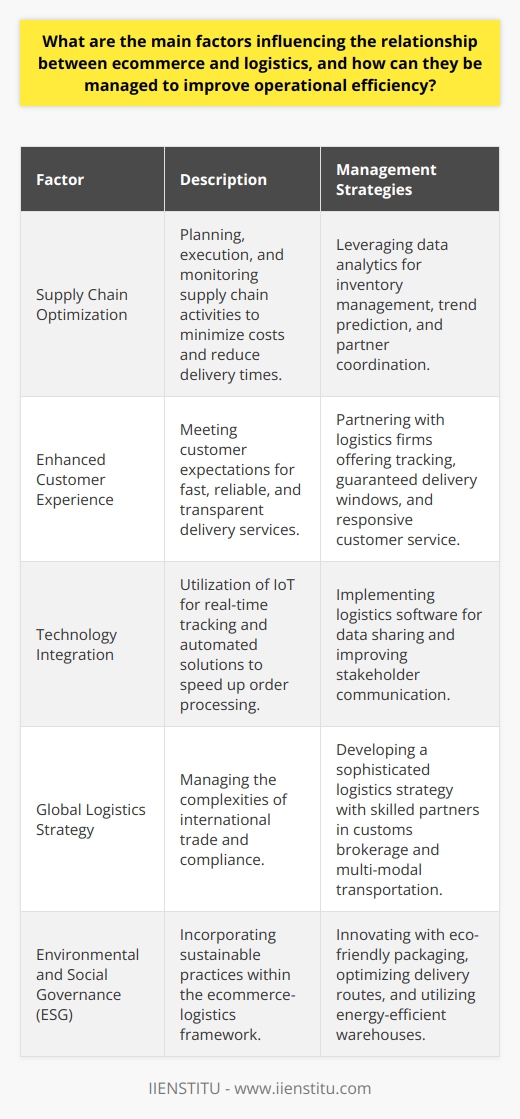
What is the role of e-commerce in supply chain management?
Role of E-Commerce in SCM
The role of e-commerce in supply chain management (SCM) derives primarily from its capacity to facilitate a seamless flow of information and goods across the global marketplace. Essentially, e-commerce enhances supply chain efficiency by streamlining processes and reducing costs, leading to improved customer satisfaction and increased profits.
Integration of Functions
Through e-commerce, suppliers and customers can better integrate their functions, leading to increased visibility and improved demand forecasting. As online platforms automate various processes such as inventory management, procurement, and shipping, businesses save time and resources, allowing for more efficient allocation of resources.
Cost Reduction
One of the prime advantages of e-commerce in SCM is the substantial reduction in operational costs. As digital transactions eliminate the need for physical infrastructure, businesses can minimize their overhead expenses. Moreover, automation and digitization render tedious paperwork redundant, reducing the margin of human error and facilitating cost control.
Improved Communication
E-commerce platforms foster improved coordination between various stakeholders along the supply chain by promoting a real-time exchange of information. With the availability of immediate communication channels, companies can closely monitor deliveries, mitigate discrepancies, and collectively manage resolution strategies for any issues that arise.
Shortening Lead Times
E-commerce can significantly impact lead times in the supply chain by expediting order processing, production, and delivery cycles. As businesses adopt digital tools for communication and collaboration, the resulting efficiency leads to reduced lead times and increased responsiveness to market demands.
Enhanced Responsiveness
With access to real-time information, supply chain managers can make informed decisions when allocating resources and addressing unexpected changes in market conditions. Consequently, e-commerce enables supply chains to increase their agility, prepare for unforeseen challenges, and exploit opportunities for growth.
In conclusion, e-commerce plays a pivotal role in revolutionizing supply chain management by driving efficiency, reducing costs, improving communication, shortening lead times, and enhancing responsiveness in today's dynamic and globalized business environment.
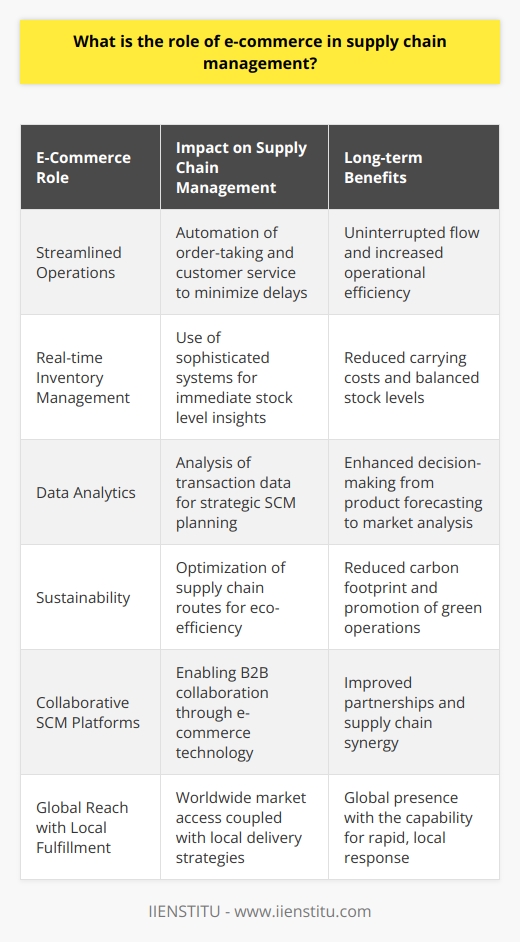
How do you set up a supply chain for e-commerce?
Establishing an E-commerce Supply Chain
Initial Assessment
To set up a supply chain for e-commerce, begin with an assessment of the specific requirements and target market of the business. Identifying product categories, customer profiles, and geographical reach will help evaluate appropriate supply chain models.
Selecting Suppliers
Next, select reliable suppliers and partners. Consider factors such as the quality, cost, and location of potential suppliers. Additionally, ensure that chosen partners align with the ethical and environmental standards of the business.
Inventory Management
Effective inventory management is crucial for e-commerce success. Develop a just-in-time inventory management system, which minimizes excess stock while maintaining product availability. Implement efficient stock tracking to avoid overselling and disappointing customers.
Warehouse Management
A well-organized warehouse helps businesses maintain control over inventory levels and fulfillment processes. Invest in warehouse management software to streamline picking, packing, and shipping processes. Automate repetitive tasks to minimize human error and improve overall operational efficiency.
Shipping and Delivery
Fast shipping and delivery play a significant role in customer satisfaction. Collaborate with shipping companies that not only offer competitive pricing, but also have a reputation for timely deliveries. In some cases, utilizing multiple shipping carriers can provide the best mix of pricing, speed, and reliability for the business.
Returns and Reverse Logistics
E-commerce businesses must have a clear returns and reverse logistics policy in place. Addressing customer returns and exchanges promptly ensures customer satisfaction and reduces the financial impact of returns on the business. Implement processes that allow easy returns and proper disposal or recycling of returned products.
Technological Integration
Integrate supply chain systems with e-commerce platforms using software solutions to ensure seamless data exchange. Keep the business updated with changing technology trends, as it helps monitor supply chain performance, refine processes, and address potential weak points.
Monitoring and Optimization
Continuously monitor the supply chain and optimize it for efficiency and cost-effectiveness. By regularly evaluating the performance of suppliers, warehouse management, and shipping carriers, an e-commerce business can remain competitive and responsive to customers' needs.
In conclusion, establishing a supply chain for e-commerce requires businesses to carefully consider suppliers, inventory management, warehouse operations, shipping, returns, technology, and monitoring for optimal success. Flexibility and adaptability to changing market conditions and technologies will help ensure a competitive edge in the dynamic e-commerce landscape.

What are the components of e-logistics?
Components of E-Logistics
E-logistics, also known as electronic logistics, is a comprehensive approach to managing the flow of goods and information in a supply chain. Several key components contribute to its efficiency and effectiveness.
Supply Chain Integration
A crucial element of e-logistics is the integration of all supply chain processes, from procurement to delivery. This includes connecting suppliers, manufacturers, distributors, and retailers through digital platforms, enhancing communication and coordination.
Inventory Management
Effective inventory management is essential to streamlining the e-logistics process. Accurate tracking of inventory levels allows businesses to predict demand, optimize warehouse space, and prevent stockouts or overstocking.
Order Management
Managing orders efficiently is fundamental to e-logistics. Technology plays a vital role in automating order processing, including order placement, tracking, and fulfillment. This results in reduced errors, improved customer satisfaction, and increased overall efficiency.
Transportation Management
Optimizing transportation management ensures timely deliveries and enhances the overall e-logistics process. This involves selecting the appropriate shipping method, route planning, and tracking shipments in real-time.
Warehouse Management
Efficient warehouse management includes maintaining the organization of stored goods, minimizing handling time, and implementing advanced technologies to track and locate items. This component is critical for ensuring smooth order fulfillment.
Information Technology
E-logistics relies heavily on advanced information technologies (IT) such as electronic data interchange (EDI), radio frequency identification (RFID), and global positioning systems (GPS). These technologies improve data exchange, tracking, and location services within the supply chain.
Customer Relationship Management
Customer relationship management (CRM) focuses on meeting customer needs and expectations. In the context of e-logistics, CRM involves using customer feedback and data analysis to improve service quality, product offerings, and overall customer satisfaction.
To conclude, e-logistics consists of several essential components that collectively enable the efficient management of supply chains. By integrating supply chain processes, optimizing inventory and transportation management, and leveraging advanced IT solutions, e-logistics drives seamless order fulfillment and enhanced customer satisfaction.
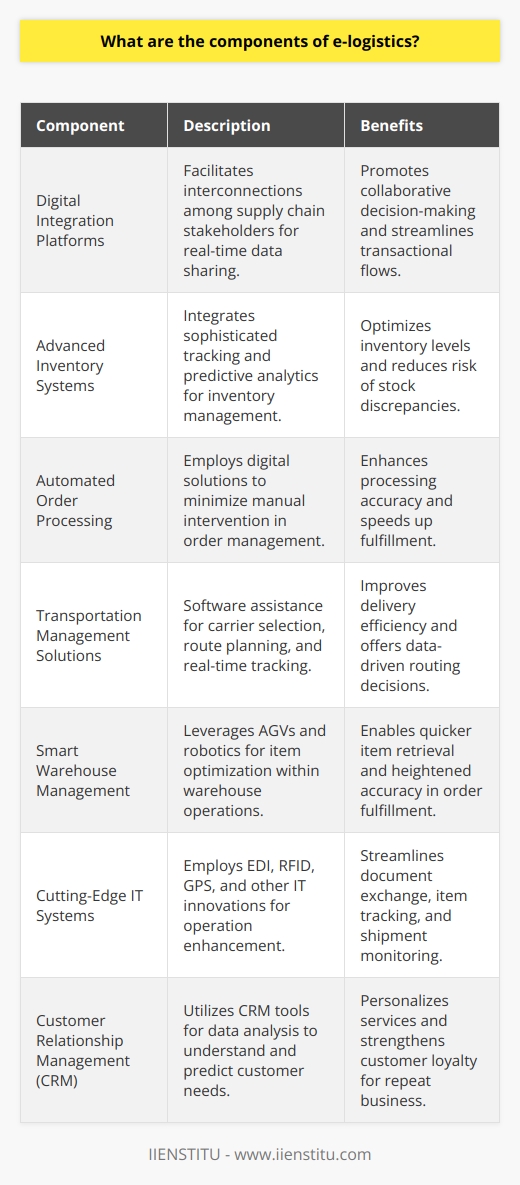
What are the benefits of e-business logistics?
Efficiency Enhancement
E-business logistics can significantly enhance efficiency. Electronic systems can process orders rapidly, minimizing human errors. Quick and accurate order processing leads to timely deliveries, allowing for better customer satisfaction.
Cost Reductions
Additionally, e-business logistics can lower costs. Traditional business logistics requires manual labor for inventory management and product distribution. The automation of these processes due to e-logistics can significantly decrease labor costs. Also, upon integrating the supply chain, businesses no longer need vast storage spaces, reducing overhead expenses.
Customer Experience Improvement
E-business logistics can also improve customer experience. A well-organized e-business setup presents accurate real-time information to customers. They can track their orders and know exact delivery periods. An excellent customer experience usually translates to repeat business, boosting profits.
Worldwide Market Access
Another benefit of e-business logistics is the easy access to markets across the globe. Traditional logistics practices can limit operations within geographical boundaries. However, e-business bypasses these barriers. It delivers goods and services to customers worldwide, thereby increasing market reach.
Sustainability
Lastly, e-business logistics contribute to environmental sustainability. The reduction in paper documentation and move towards digital formats causes less harm to the environment. Also, efficient delivery routes lower fuel consumption, thus reducing carbon emissions.
In conclusion, the adoption of e-business logistics presents numerous benefits. These include improved efficiency, cost reductions, better customer experience, access to global markets, and contributions to environmental sustainability. Therefore, embracing e-business logistics is key to thriving in the contemporary business landscape.

What is the underlying infrastructure needed to support e-commerce logistics and its scalability?
Infrastructure Requirements
E-commerce logistics relies on a robust infrastructure. An efficient IT platform, including software for inventory management, order tracking and customer service, forms the backbone of the infrastructure. In addition, integrated systems for payment processing, shipping and handling, and data security are essential for smooth operations. A high-speed, reliable internet connection is also fundamental to ensure uninterrupted services.
Physical Fulfillment Centers
At the physical level, the presence of adequate storage facilities or fulfillment centers is necessary. These locations hold inventory, manage orders, and package products for dispatch. They must be strategically located for faster delivery and reducing logistical costs.
Scalability Considerations
Scalability in e-commerce logistics means the capacity to manage growth effectively. As demand increases, logistics infrastructure must expand without compromising efficiency or customer satisfaction. This requires flexible IT systems that can adapt and scale to changing business needs.
On the physical level, scalable logistics may involve expanding storage facilities or collaborating with third-party logistics providers. Finally, an agile logistics workforce that can manage increased demand during peak seasons forms an essential part of a scalable e-commerce logistics infrastructure.
Conclusion
In conclusion, a combination of advanced IT systems, physical structures and strategic planning forms the infrastructure necessary for e-commerce logistics. Moreover, successful scalability depends largely on the flexibility and adaptability of these elements. With robust infrastructure and proper scalability strategies, e-commerce businesses can effectively manage growth and provide consistent quality service.
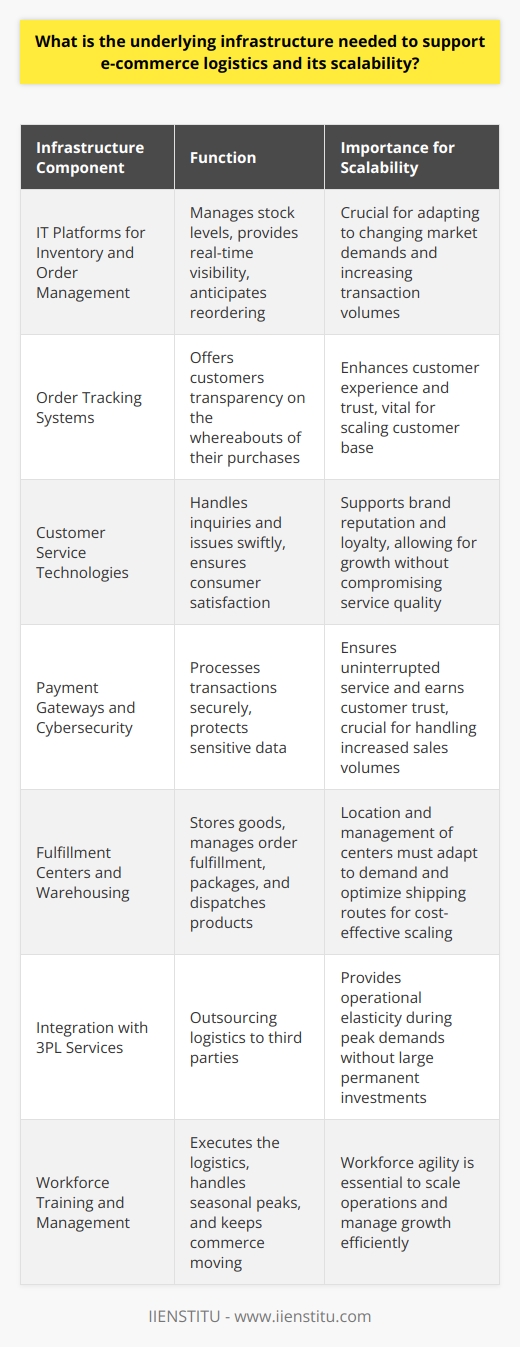
How does integrating e-commerce logistics affect the overall customer experience in an online retail environment?
Improved Delivery Speed
Integrating e-commerce logistics accelerates delivery speed. Online consumers value swift and efficient services. Fast delivery enhances customer satisfaction and fosters loyalty.
Streamlined Processes
E-commerce logistics simplify buying processes. They merge key components such as inventory management, order fulfillment, and shipping. These streamlined operations enhance efficiency, reduce errors, and save time. Consequently, this improves the customer experience by ensuring order accuracy and prompt delivery.
Enhanced Tracking Capabilities
Customers can track their orders in real-time when a business integrates logistics. Real-time tracking provides transparency, eliminates uncertainty, and boosts buyer confidence. This transparency improves customer confidence and overall satisfaction.
Improved Inventory Management
Effective e-commerce logistics integrate inventory management. They ensure that stock levels align with demand, avoiding out-of-stock items or overstocking. Efficient inventory management results in fewer customer disappointments and more repeat purchases.
Customized Shipping Options
Logistics integration offers more shipping options. Customers can choose from overnight shipping, standard shipping, or in-store pickups. Flexible shipping options increase customer satisfaction and cater to their individual preferences.
Reduced Returns and Refunds
Lastly, well-implemented e-commerce logistics reduce the frequency of order returns and refunds. If customers receive the correct order on time, they are less likely to request refunds or return items. This enhances customer satisfaction and encourages repeated purchases.
In conclusion, integrating e-commerce logistics significantly enhances the overall customer experience in an online retail environment. This strategy leads to faster delivery, better order tracking, improved inventory management, flexible shipping options, and fewer returns and refunds. Hence, to guarantee customer satisfaction and loyalty, retailers should consider integrating e-commerce logistics into their operations.
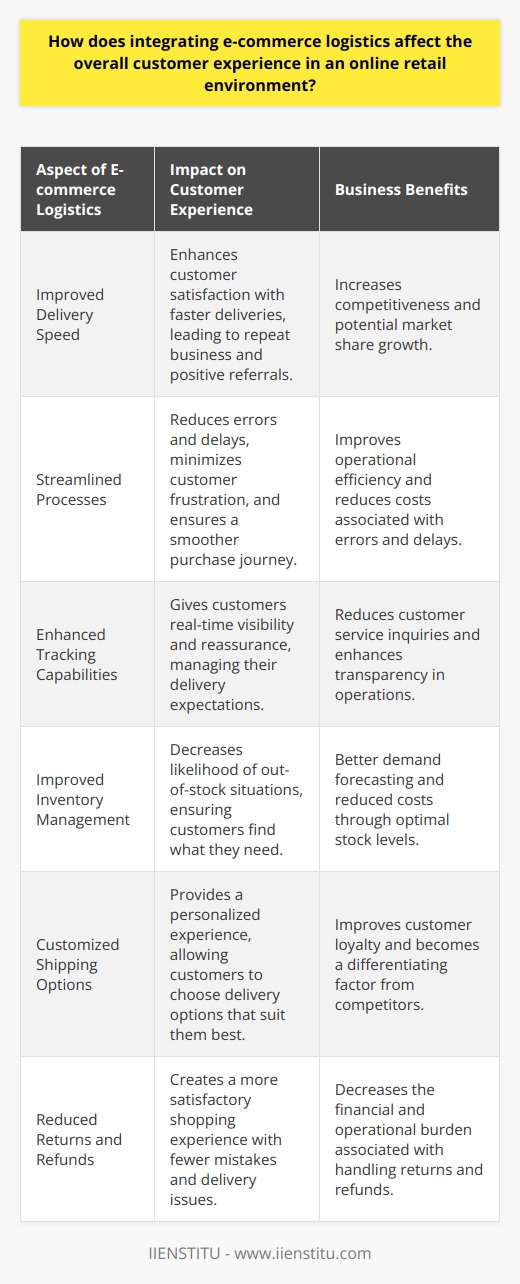
What is the role of e-commerce in streamlining and enhancing the process of supply chain management?
Efficiency in Online Transactions
E-commerce plays a significant part in streamlining supply chain management by enhancing efficiency in online transactions. Incorporating digital platforms in managing the supply chain enables real-time tracking of goods, reducing bottlenecks in the movement of commodities.
Enabling Real-Time Tracking
Through the digital tracking mechanisms, the supply chain manager can instantly identify any logistical hitches and figure out corrective measures. Thus, it accelerates the delivery process.
Streamlining Information Flow
Additionally, e-commerce facilitates the immediate exchange and streamlining of information among various participants in the supply chain. Real-time communication fosters effective decision-making processes, contributing to the efficiency of the supply chain.
Enhancing Customer Experience
Notably, e-commerce forms an integral part in enhancing customer experience through providing detailed product information and facilitating timely delivery. Having these customer-centric features builds trust and drives customer loyalty hence, promoting overall business growth.
Minimizing Operational Costs
E-commerce further pushes boundaries in curtailing operational costs. Automation of procedures reduces the need for manual inputs and thus, cuts on labor costs. Also, digitalization means firms can operate without physical stores, significantly slashing the expenditure on premise rent and maintenance.
In conclusion, the role of e-commerce in supply chain management is immense. From aiding real-time tracking, streamlining information flow, to minimizing operational costs, e-commerce revolutionizes supply chain management processes by improving efficiency, enhancing customer experience, and promoting cost-effectiveness. Its significance in today's digital age is monumental and indispensable.
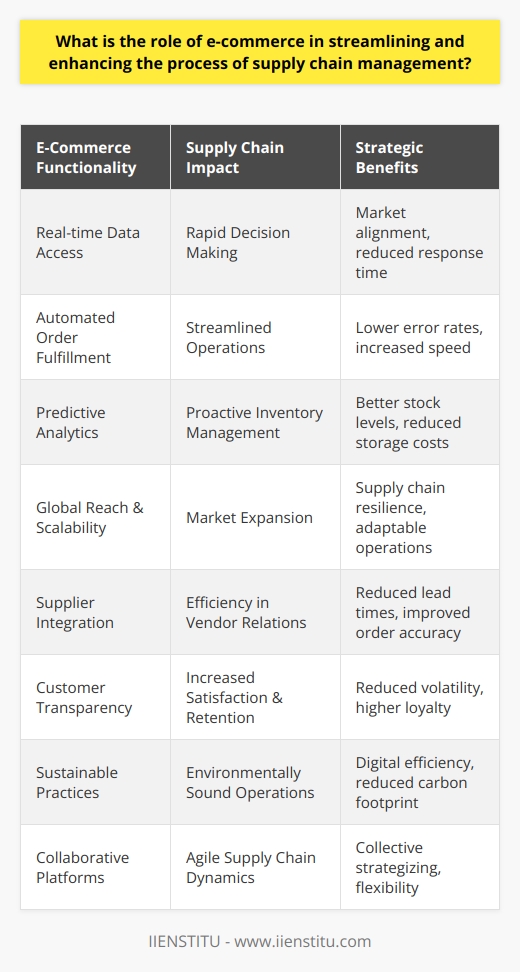
How do advancements in technology, such as automation and robotics, impact the efficacy of e-commerce logistics?
Impacts of Technological Advancements on E-commerce Logistics
Technological advancements significantly boost the efficacy of e-commerce logistics. Automation and robotics, for example, enhance efficiency by minimizing human error. They ensure precision in order picking, packing, and dispatch processes, reducing discrepancies and customer complaints.
Increased Speed and Accuracy
Automated systems perform tasks faster than humans, accelerating order fulfillment. Robots maintain accuracy in inventory management, lowering the chances of out-of-stock or overstock situations. This leads to a more balanced stock level, crucial for successful e-commerce operations.
Reduced Cost
Automation reduces labor costs. Robotic process automation requires an initial investment but promises low long-term expenses. As operational costs reduce, it becomes possible to offer customers competitive product prices.
Improved Customer Satisfaction
An efficient logistics system leads to faster delivery times, boosting customer satisfaction. Robotic assistance ensures the order accuracy, which in turn decreases return rates. Happy customers contribute to a positive reputation and higher sales.
Integration Capabilities
These technological advancements also offer system integration capabilities. They seamlessly connect different nodes like inventory, sales, and delivery, offering a panoramic view of the supply chain. This assists in forecasting, decision making, and maintaining the operational flow.
Therefore, it's manifest that automation and robotics transform the landscape of e-commerce logistics by refining efficiency and customer service. They act as catalysts for growth by enabling faster order processing, ensuring inventory accuracy, reducing costs, and enabling seamless system integration. Examining these impacts, it's clear that these technologies are not just advancements; they are necessities for the contemporary e-commerce industry.
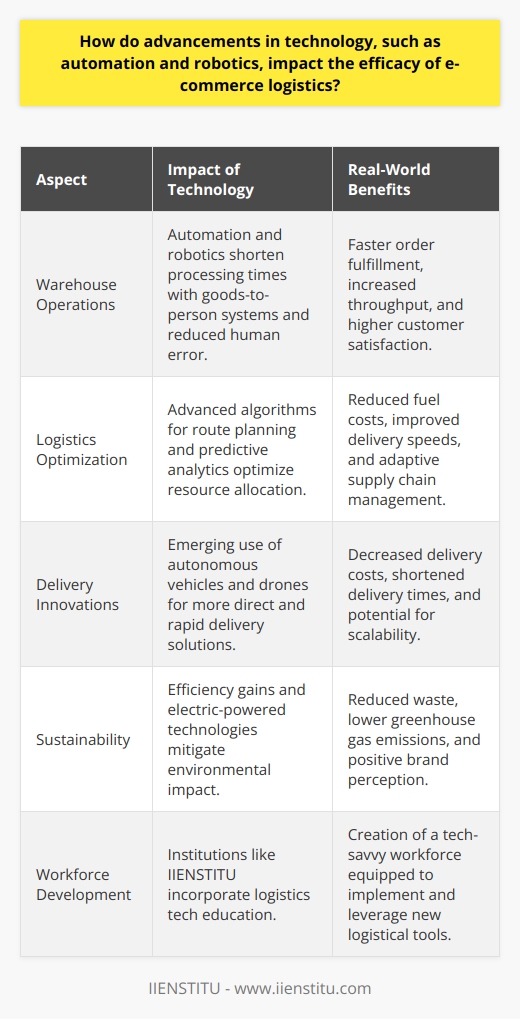
What are some strategies for effectively managing demand fluctuations and reducing supply chain disruptions in an e-commerce-oriented business model?
Demand Management Strategies
E-commerce businesses can manage demand fluctuations by implementing dynamic pricing mechanisms. Dynamic pricing hinges on real-time supply and demand data, allowing companies to adjust prices as market conditions change. This method assists in matching demand with supply, lessening the chance of either surplus or deficit.
Operational Flexibility
Operational flexibility is another strategy for managing demand fluctuations. Often, e-commerce companies can use their technology infrastructure to swiftly switch between different product lines or service offerings in response to evolving consumer demands. Operational flexibility can include adjusting production schedules or leveraging drop-shipping arrangements to fulfill orders directly from suppliers.
Inventory Management
Efficient inventory management is a critical strategy for reducing supply chain disruptions. This includes the use of just-in-time inventory systems that maintain only necessary stock levels to meet immediate demand. Lower stock levels not only minimize storage costs but also decrease the risk of inventory obsolescence due to fluctuating consumer demand.
Predictive Analytics
E-commerce companies can also rely on predictive analytics to manage demand fluctuations. This involves the use of data, statistical algorithms, and machine learning techniques to identify future trends and behaviors. Predictive analytics not only helps with forecasting but provides insights for strategic decision-making related to inventory, pricing, and supply chain management.
Supply Chain Relationships
Building strong relationships with suppliers can also lessen supply chain disruptions. This encourages timely communication and allows e-commerce companies to preempt issues. A strong supply chain network facilitates smooth operations, reduces the risk of delays, and maintains customer satisfaction.
In conclusion, e-commerce-oriented businesses can effectively manage demand fluctuations and reduce supply chain disruptions through dynamic pricing, operational flexibility, efficient inventory management, predictive analytics, and fostering strong supplier relationships. These strategies ensure smooth operations, cost-effectiveness, and overall business growth.
